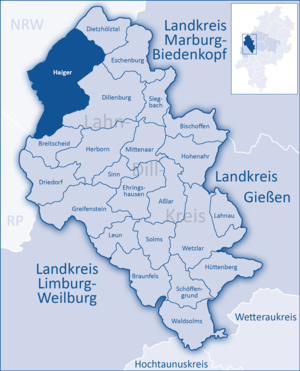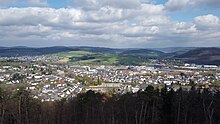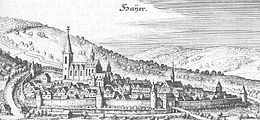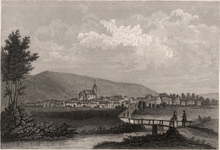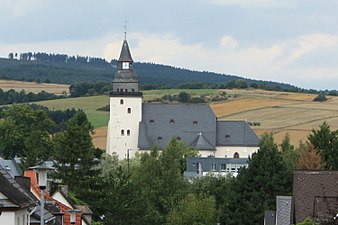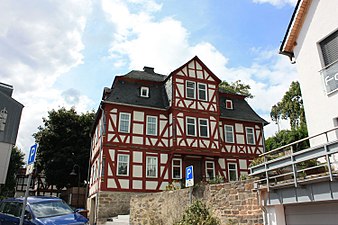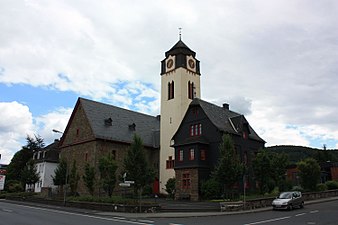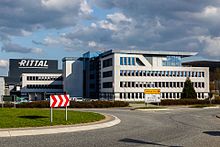Haiger
| coat of arms | Germany map | |
|---|---|---|

|
Coordinates: 50 ° 45 ' N , 8 ° 12' E |
|
| Basic data | ||
| State : | Hesse | |
| Administrative region : | to water | |
| County : | Lahn-Dill district | |
| Height : | 273 m above sea level NHN | |
| Area : | 106.67 km 2 | |
| Residents: | 19,382 (Dec. 31, 2019) | |
| Population density : | 182 inhabitants per km 2 | |
| Postal code : | 35708 | |
| Primaries : | 02771, 02773, 02774 | |
| License plate : | LDK, DIL | |
| Community key : | 06 5 32 011 | |
| LOCODE : | DE HAR | |
| City structure: | 14 districts (including core city) |
|
City administration address : |
Marktplatz 7 35708 Haiger |
|
| Website : | ||
| Mayor : | Mario Schramm (independent) | |
| Location of the town of Haiger in the Lahn-Dill district | ||
Haiger is a town in the northern part of the Lahn-Dill district in central Hesse and lies between the towns of Wetzlar and Siegen .
geography
location
Haiger is located on the eastern edge of the Westerwald or on the southern foothills of the Rothaargebirge ( Kalteiche ) about nine kilometers northeast of the triangle of Hesse-North Rhine-Westphalia-Rhineland-Palatinate and is also the largest in terms of area, but fourth largest in terms of population after Wetzlar , Dillenburg , Herborn and northernmost city in the Lahn-Dill district . The Dill rises north of the Offdilln district and the Heller rises north of the “Haiger-Kalteiche” commercial and industrial area .
Neighboring communities
Haiger borders in the north on the town of Netphen ( Siegen-Wittgenstein district in North Rhine-Westphalia ) and the municipality of Dietzhölztal , in the east on the municipality of Eschenburg and the town of Dillenburg , in the south on the municipality of Breitscheid (all in the Lahn-Dill district), and in the west to the municipalities of Burbach and Wilnsdorf (both in the Siegen-Wittgenstein district in North Rhine-Westphalia).
City structure
In addition to the core town of Haiger, the city also includes the districts of Sechshelden , Langenaubach , Flammersbach , Allendorf with the Kalteiche, Seelbach , Steinbach , Rodenbach , Fellerdilln , Dillbrecht , Offdilln , Weidelbach , Oberroßbach and Niederroßbach residential areas .
history
The first documentary mention of Haiger in the Lorsch Codex comes from the year 778: The noble Theutbirg donated her possessions in Haigrahe to the Lorsch Monastery on Bergstrasse . The donation was renewed and increased in 781. Haiger is the oldest of the three cities on the Dill, ahead of Dillenburg and Herborn . The former Haiger has its center on today's church hill. In the 9th century there was a baptistery and a royal court Heigera , which King Konrad I donated to the Walpurgis pen in Weilburg on April 14, 914, together with the market rights, the tithe and the third part of the royal shepherd . The market right must therefore have already been granted at this point in time. Up until the 10th century, Haiger was the center of the Haigerer Mark or the Haigergau , probably a Untergau of the Oberlahngau . Worms tradition shows that in 1048 Archbishop Eberhard von Trier and the Bishop of Worms consecrated the new construction or expansion of the Haiger city church, which is still Haiger's landmark today. Knight Udo von Haiger is mentioned on April 1st, 1159 as the first nobleman of the von Haiger family. The mention of Udo (presumably as a witness) takes place in the course of the enfeoffment of the Counts of Laurenburg with Nassau Castle by the Archbishop of Trier.
With the end of the Conradin family, the Haigerer Mark passed to the Count Palatine . They gave him as a fief to the Lords of Molsberg . These transferred the rule to the lower nobility "von Haiger". From the 13th century the Counts of Nassau increasingly penetrated the area of the Haigerer Mark and the neighboring Herborn Mark . The Dernbacher feud broke out between Nassau and the Landgraves of Hesse . The Nassau counts were able to assert themselves on the Dill. In the early 14th century the judicial rights over Haiger finally came to the counts from the House of Nassau.
see also Haiger Castle
In 1457 the first Haiger iron smelter ("Haigerhütte") is mentioned. Iron ore was already being mined in the Haiger area at that time (see also the list of mines in Haiger ).
Around 1490, Hermann von Haiger and his son Jost von Haiger , the last Haiger knight, decorated the church choir with frescoes. Approx. 90 years later these are whitewashed and forgotten. They are not rediscovered until the beginning of the 20th century (1904).
During the Nassau rule, Haiger developed an urban area without granting city rights . The location at the meeting of the three valleys Haigerbachtal, Aubachtal and Dilltal was conveniently located and close to the long-distance trade route from Cologne to Leipzig (“ Brabanter Strasse ”).
In 1603 the plague raged in the city. In November 1623, Spanish soldiers from the Don Lorenzo de Mestro Haiger regiment looted and pillaged. Before they left, the city caught fire due to inattention. 70 buildings, including 40 residential houses, went up in flames. The damage was estimated at half a million Reichstaler. At the beginning of winter, 250 Haiger residents were left with practically nothing. A short time after the fire, the plague broke out again and killed entire families.
An uprising in the city causes the citizens to receive their council six in 1672 , a say in city decisions through a representation of six councils.
On May 8, 1723, the entire city center of Haiger was destroyed by a fire. In a few hours, almost all the buildings within the city walls burned down. The church roof burned down, but not the church itself. The quick financial help from the surrounding principalities, cities and countries, as well as a generous donation from Princess Isabella (a "legacy of 400 Floren Capitäl!") Helped to alleviate the great need. The four-gate, tower-reinforced city wall, which also ran between the Aubach and the southern city limits, was seen as an obstacle to fire fighting and was laid down in 1824. This enabled the city to reorganize and expand as planned. Further city fires that caused greater damage took place in 1827 and 1829.
On February 23, 1849, a citizens' initiative of 56 marriageable men and 49 women thwarted the introduction of a municipal marriage tax of 10 guilders.
The Haiger train station was opened in the field in front of the city on January 12, 1862 and has been connecting Haiger with the world ever since. On December 17, 1898, a narrow-gauge railway that delivered ores from the Constanze mine to the station was opened. Pit the grace of God from the Hachelbach there. This station also became the starting point of the 12.3 kilometer Haiger – Breitscheid railway on December 15, 1926 .
Shortly before the start of the Second World War , several Jewish families lived in Haiger, who had fled or were killed after the occasional destruction in the so-called Reichskristallnacht and further hostility up to the outbreak of war in 1939. During the World War, numerous forced laborers and Russian prisoners of war were housed in Haiger and the surrounding area. A memorial not far from the central cemetery commemorates this.
During the Second World War, large parts of the Upper Town were also destroyed by Allied bombing. There were more than 72 dead and numerous injured. The main attacks took place on March 12 and 14, 1945 by the 8th US Air Force . In the years 1944–1945 there were numerous night and day attacks (presumably) by American fighter-bombers (popularly known as "Iron Gustav"). Presumably the Siegen-Giessen railway line was the main destination as well as numerous ammunition and supply trains that often came to a standstill at the old station. During air raids, u. a. the Catholic Church completed in 1930 (March 12) and the old school were badly damaged. Haiger was captured or liberated by parts of the US Army in April / May 1945 (1st US Army under Gen. Hodges). In the city center and around Haiger there were still scattered remnants of German troops, luck and chance prevented another devastating attack by Allied bombers.
Incorporations
As part of the regional reform in Hesse , Flammersbach was incorporated into the town of Haiger on January 1, 1970 on a voluntary basis . On February 1, 1971, until then independent municipality was Rodenbach also voluntarily incorporated . The municipality of Dillbrecht followed on October 1, 1971.
On January 1, 1977, the previously independent communities of Allendorf , Fellerdilln , Haigerseelbach , Langenaubach , Offdilln , Roßbachtal , which had arisen on October 1, 1971 through the voluntary merger of the communities of Niederroßbach and Oberroßbach , Sechshelden , Steinbach and Weidelbach became part of the city by virtue of state law Haiger incorporated. Local districts were not established.
Naming
The city name Haiger comes from the Old Hessen: The large number of herons on the Haigerbach, Aubach and the dill contributed to the name “Reiherbach”, or “Heigerahe” in Old Hessen. This name consists of the terms "Heiger", meaning heron, and "Ahe", meaning stream or body of water. In the course of history, this spelling changed via the words → "Heigrahe" → "Heigera" → "Heigere" → "Heigerin" → "Heigre" → "Heigeren" → "Hegere" → "Hegera" → "Heygere" → "Heyger “→“ Heiger ”→“ Häger ”→ and“ Häyer ”towards the name Haiger. The bird in the Haiger coat of arms could also refer to the heron, as well as a change in the Nassau lion. Another, today rather rejected, interpretation of the name genesis sees the origin of the jay (from jay ). Is argued u. a. so that the bird in the city coat of arms does not resemble a heron.
Territorial history and administration
The following list gives an overview of the territories in which Haiger was located and the administrative units to which it was subordinate:
- 914: in pago Heigera , Heigera [cop. 12th century Struck, sources on the history of the monasteries 2, no. 1048]
- 1048: County in the Haigermark ( sicuti ductus est comitatus in Heigeromarca ), Heigerin, in loco [cop. Middle of the 12th century Struck, sources for the history of the monasteries 2, pp. 444–446 No. 1053]
- before 1739: Holy Roman Empire , County / Principality of Nassau-Dillenburg , Haiger Office
- from 1739: Holy Roman Empire, Principality of Nassau-Diez , Haiger Office
- 1806–1813: Grand Duchy of Berg , Department of Sieg , Canton of Dillenburg
- 1813–1815: Principality of Nassau-Orange , Haiger Office
- from 1816: German Confederation , Duchy of Nassau , Dillenburg office
- from 1849: German Confederation, Duchy of Nassau, Herborn district office
- from 1854: German Confederation, Duchy of Nassau, Dillenburg Office
- from 1867: North German Confederation , Kingdom of Prussia , Province of Hessen-Nassau , Administrative Region of Wiesbaden , Dillkreis
- from 1871: German Empire , Kingdom of Prussia, Province of Hessen-Nassau, administrative district of Wiesbaden, Dillkreis
- from 1918: German Empire, Free State of Prussia , Province of Hessen-Nassau, Administrative Region of Wiesbaden, Dillkreis
- from 1932: German Empire, Free State of Prussia, Province of Hesse-Nassau, District of Wiesbaden, District of Dillenburg
- from 1933: German Reich, Free State of Prussia, Province of Hessen-Nassau, Administrative Region of Wiesbaden, Dillkreis
- from 1944: German Empire, Free State of Prussia, Nassau Province , Dill District
- from 1945: American occupation zone , Greater Hesse , Wiesbaden district, Dillkreis
- from 1949: Federal Republic of Germany , State of Hesse , Wiesbaden district, Dillkreis
- from 1968: Federal Republic of Germany, State of Hesse, administrative district Darmstadt , Dillkreis
- from 1977: Federal Republic of Germany, State of Hesse, Darmstadt administrative district, Lahn-Dill district
- from 1981: Federal Republic of Germany, State of Hesse, Gießen administrative district , Lahn-Dill district
Population development
The numbers refer only to the municipality capital Haiger.
- 1885: 1553 Protestant (= 93.50%), 80 Catholic (= 4.82%), 23 other Christians (= 1.38%), 5 Jews (= 0.30%)
- 1961: 3127 Protestant (= 75.11%), 879 Catholic (= 21.11%) inhabitants
- 2005: 2354 Protestant (= 43.54%), 785 Catholic (= 14.52%) and 2561 other (= 47.37%) residents
| Haiger: Population from 1623 to 2016 | ||||
|---|---|---|---|---|
| year | Residents | |||
| 1623 | 250 | |||
| 1834 | 1,142 | |||
| 1840 | 1,141 | |||
| 1846 | 1,114 | |||
| 1852 | 1,121 | |||
| 1858 | 1,179 | |||
| 1864 | 1,304 | |||
| 1871 | 1,417 | |||
| 1875 | 1,504 | |||
| 1885 | 1,661 | |||
| 1895 | 1,707 | |||
| 1905 | 2.140 | |||
| 1910 | 2,249 | |||
| 1925 | 2,705 | |||
| 1939 | 2,722 | |||
| 1946 | 3,331 | |||
| 1950 | 3,621 | |||
| 1956 | 3,884 | |||
| 1961 | 4.163 | |||
| 1967 | 4,430 | |||
| 1970 | 5,276 | |||
| 1980 | ? | |||
| 1990 | ? | |||
| 2005 | 5,406 | |||
| 2016 | 5,482 | |||
| Data source: Historical municipality register for Hesse: The population of the municipalities from 1834 to 1967. Wiesbaden: Hessisches Statistisches Landesamt, 1968. Further sources:; after 1970: | ||||
Population figures including the places incorporated into Hesse in the course of the regional reform .
| Haiger: Population figures from 1972 to 2015 | ||||
|---|---|---|---|---|
| year | Residents | |||
| 1972 | 6,728 | |||
| 1976 | 17,805 | |||
| 1984 | 17,851 | |||
| 1992 | 21,074 | |||
| 2000 | 20,200 | |||
| 2004 | 19,959 | |||
| 2010 | 19.306 | |||
| 2015 | 19,200 | |||
| Sources: 1972 :; 1976 :; 1984 :; 1992 :; 2000, 2015 :; 2004 :; 2010: | ||||
politics
magistrate
Mario Schramm (independent), First City Councilor Sebastian Pulfrich (CDU), has been the mayor since July 1, 2014.
City Council
The local elections on March 6, 2016 produced the following results, compared to previous local elections:
| Parties and constituencies | % 2016 |
Seats 2016 |
% 2011 |
Seats 2011 |
% 2006 |
Seats 2006 |
% 2001 |
Seats 2001 |
||
|---|---|---|---|---|---|---|---|---|---|---|
| CDU | Christian Democratic Union of Germany | 45.0 | 17th | 46.6 | 17th | 44.5 | 16 | 36.8 | 14th | |
| SPD | Social Democratic Party of Germany | 25.9 | 9 | 32.7 | 12 | 27.4 | 10 | 34.2 | 13 | |
| FWG-Haiger | Free community of voters Haiger | 21.6 | 8th | 16.1 | 6th | 9.9 | 4th | - | - | |
| FDP | Free Democratic Party | 7.6 | 3 | 4.5 | 2 | 4.3 | 2 | 3.7 | 1 | |
| REP | The Republicans | - | - | - | - | 7.7 | 3 | 9.0 | 3 | |
| NLA | Living and working, of course | - | - | - | - | 6.2 | 2 | 8.6 | 3 | |
| BL-FWG | Citizens List-Free Voting Community | - | - | - | - | - | - | 7.7 | 3 | |
| total | 100.0 | 37 | 100.0 | 37 | 100.0 | 37 | 100.0 | 37 | ||
| Voter turnout in% | 43.0 | 36.3 | 35.2 | 40.5 | ||||||
Community partnerships
- Haiger - Montville (Seine-Maritime) , France
The partnership was created on the initiative of the Johann Textor School in Haiger, which has maintained a student exchange with the Collège Noel in Montville for around 20 years. This friendship was officially sealed in 1991 in Montville and 1992 in Haiger by the signing of a certificate by the mayors of Montville and Haiger. Citizens, associations and groups maintain lively contact.
- Haiger-Sechshelden - Plombières-lès-Dijon , France
In 1964, the town of Plombières-lès-Dijon and the then still independent municipality of Sechshelden officially sealed this partnership, the origin of which goes back to the caring reception of a former French prisoner of war by the Sechshelden families. The circle expanded through friendly relations between citizens of both communities.
- Haiger - Wolfsberg (Thuringia)
The friendship between Haiger and the former community of Wolfsberg has existed since 1991. Shortly after German-German reunification , the mayors at the time had signed the partnership “with a handshake”. “Back then we didn't have time for a certificate or contract.” This is why we speak of an unsealed partnership. The beginning of the friendship was marked by work: Wolfsberg took over all administrative papers: "In the first years after reunification, the political bodies and the administration of the city of Haiger supported the community of Wolfsberg in Thuringia in establishing a new administrative structure." Twenty years later The association works in Wolfsberg with Haiger's cameralistics (in Haiger, double housekeeping has meanwhile been converted). In 1994, Haiger fire service comrades transferred a fire engine to the Thuringian twin town. In Haiger, the "Thuringian Days" take place annually, mostly in September, to celebrate friendship.
Hessentag 2022
On March 20, 2018, Haiger was awarded the contract for the Hessentag 2022 by Prime Minister Volker Bouffier. As early as 2015, the will was expressed to host the 62nd edition of the state festival here. On December 17, 2015, the Hessian state government received the corresponding application documents, which was underpinned by the visit of State Minister Axel Wintermeyer in autumn 2017 : He got an idea on site and spoke out in favor of the Hessentag taking place in Haiger after 2020. Since the event in Fulda will increase in 2021, the award will be made for the year 2022. This is the third time the Hessentag has stopped in the Lahn-Dill district in a decade : In 2012 it was held in Wetzlar; the Hessentag 2016 took place in Herborn. The festival should be close to the city center z. B. be carried out on the large company premises of the Rittal company and at Haigerbach . Parking spaces are planned near Autobahn 45 - a temporary exit will also be built at the "Haiger Viaduct". "Innovative economy, ecology and energy" is planned as the motto, since the close connection between economy and Hessentag will define the character in Haiger. The city has appointed four Hessentag officers who are to lead the organization in the coming years: Julia Bastian (Deputy Head of the Office), Timo Dietermann (Deputy Head of the Public Order Office) and Oliver Thielmann (Office of the Public Order Office).
Culture and sights
Museums
- Haiger local history museum
On the occasion of the 1200th anniversary of Haiger's first mentioning, the local history museum on the market square was set up in one of the most beautiful half-timbered buildings from 1724/25. The natural, historical, economic and folkloric conditions of the city of Haiger and the area assigned to it are shown.
- The Haigerseelbach Linen and Lace Museum
The only linen and lace museum in Hesse is located in the old town hall of the Haigerseelbach district. Here the production of clothing made of flax is shown, as well as the products made from it. Renewable raw materials are the newest part of the exhibition.
- Sechshelden home office
The home parlor of the Haiger district is located in the former village smithy and shows exhibits from the village history of the place first mentioned on November 1, 1371.
Buildings
The structural center of the old town of Haiger is the Protestant parish church , which is essentially a Romanesque building. Numerous half-timbered buildings from the 18th century have been preserved in the old town, but they are often plastered. The rectory and the Fischbach house , which today houses the local history museum, are particularly worth seeing .
The city began to expand in the 19th century. The Aubach Bridge (built in 1801), the Alte Wache (around 1824) and several villas have been preserved from this era . Other monuments are the Catholic Church (late 19th century) and the railway station in Art Nouveau style (built in 1913)
On the head south of Haiger is the listed Eduardsturm , a 10 m high observation tower built in 1883
Sports

- TSV Steinbach Haiger , Football Regionalliga Südwest 2018/19
- SKC Blue - Weiss Haiger
- Eintracht Haiger
- TV 1885 Haiger
- Ivanisi Ballet School
Regular events
- Old town festival
- Lukasmarkt (October)
- Pentecost market
- Christmas Market
- Thuringian days
- Live in Haiger on Fridays
- Oktoberfest
- Ice rink in Advent with winter magic
Economy and Infrastructure
traffic
Haiger is located with the Haiger train station on the Siegen – Gießen railway line and is the end point of the Betzdorf – Haiger railway line , in the course of which the Haiger-Obertor and Allendorf (Dillkr) stops are also served. The Haiger – Breitscheid railway line was shut down and has now been completely dismantled.
|
←
|
Lines |
→
|
||
|---|---|---|---|---|
| Wins |
Main-Sieg-Express |
Dillenburg | ||
| Rodenbach (Dillkr) |
Sieg-Dill-Bahn |
Six heroes | ||
| Haiger Obertor |
Hellertalbahn |
Six heroes | ||
Altogether there are over 1000 free parking spaces available in Haiger. In 2011 the new bypass (B 277) was opened so that traffic no longer has to drive through the city center.
Established businesses
- DigiTask - software company
- Hailo - production of ladders, garbage cans and built-in garbage cans, etc., was founded in Haiger in 1947
- Klingspor Schleifsysteme, moved to Haiger in 1954, and has its headquarters there today
- The Friedhelm Loh Group (with Rittal , manufacturer of control cabinets) has its headquarters in Haiger
- Weiß Chemie und Technik, manufacturer of adhesives, cleaners, sandwich and facade elements
- Carl Cloos Schweißtechnik GmbH , specialist in welding technology and welding robots
- Oranier Küchentechnik GmbH (with Justus GmbH, manufacturer of gas grills and fireplace stoves)
Cold oak industrial area
The Kalteiche industrial area is located directly at the Haiger / Burbach motorway junction on the A 45 and near Siegerland Airport (13 kilometers). The area has a gross area of 710,000 m² and is 60 hectares in 2011. In 2011 around 1000 people worked in the industrial area.
Before the development in 2000, there were civil protests, especially in the towns of Allendorf and Haiger-Seelbach, which led to the foundation of the NLA (Naturally Living and Working) party. The party immediately made the leap into the city parliament. On June 16, 2010, the party disbanded.
On May 24, 2011, the Haiger city council decided that the Kalteiche should be expanded by 17.9 hectares in order to enable further companies to settle in Haiger. The expansion is to take place in the direction of the federal road and Haiger-Seelbach.
As part of construction work, scientists from the University of Münster researched the remains of a Celtic settlement in 2000 and found a. Racing ovens , witnesses and Iron Age settlements and burial mounds.
A third extension (Kalteiche III) was started in 2018. This means that the industrial area continues to grow towards the south. Five million euros have been earmarked for the development of the area near the so-called “Shell Cross”. Since the area is derogatory, terraces have to be created. The third section is about nine acres. The third construction phase is to be connected to the confluence area B 54 / B 277 with a roundabout.
retail trade
There are four main areas of development in retail:
- “Lohwiese”: A large hardware store and several supermarkets have opened in the Lohwiese area in recent years.
- Inner city: In the inner city there are banks, pharmacies and drugstores above all small shops that also attract customers from neighboring communities with their range. Particularly noteworthy is “Fisch Goll”.
- Former Haiger Center or the former Möbel Franz site: A number of discounters and cheap segment shops have set up shop on the site of the former Haiger Center and in the former building of the insolvent Möbel Franz company. The Roller furniture store has been located in the former Möbel Franz building since 2006 .
- Former Format site: A grocery store and a gas station were built here. Originally (2010) it was considered that a shopping center should be built on the premises of the insolvent kitchen manufacturer “Format”. As a customer magnet, an electronics store should form the center of the new shopping center. The total sales area should be 8400 square meters, 500 parking spaces should be created. These plans were not implemented - even after protests from the neighboring town of Dillenburg.
media
- Haiger today
The official Haiger Bulletin was first distributed to all 7,800 Haiger households on November 24, 2016. This sheet is intended to provide free information about everything that is happening in Haiger and the 13 districts.
Local newspapers
- Haigerer Zeitung ( VRM (media company) )
education
- School at Budenberg (special needs school)
- Elderly Care School of the Lahn-Dill District (Elderly Care School)
- Primary schools (Haiger, Sechshelden , Langenaubach, Allendorf , Dillbrecht, Roßbachtal)
- Kindergarten, 3 in Haiger and 12 more in the districts.
- The Johann-Textor -Schule is the largest cooperative comprehensive school in the Lahn-Dill district, with a high school course from school years 5 to 10, a support level in years 5 and 6 as well as a subsequent secondary school and secondary school .
tourism
hike
The Rothaarsteig touches both the main path (Dillenburg-Brilon) and the Westerwald variant of the Haiger urban area. Haiger- Rodenbach is hiked through on the main path - one of the few places hikers pass through. In the Westerwald variant, the Langenaubach district is particularly affected. The "Hellerhöhenweg" of the Westerwald-Verein starts in Haiger (37 km to Betzdorf / Sieg), as does the "Dillwanderweg (right of the Dill)" (50.5 km to Wetzlar ). The "Dillwanderweg (left the Dill)" hikes through Haiger (67.2 km from Dillquelle (Haincher Höhe) to Asslar). The main route 8 of the Westerwaldverein starts in Haiger and ends after 42.5 km in Weilburg .
Geocaching
The geocache “Die Kinder des Buchbinders”, published on March 6, 2016, is considered to be one of the best geocaches in Germany and attracts several teams to Haiger every day. With 97 percent favorite points (3965, as of December 10, 2019), it has the highest value nationwide.
Personalities
sons and daughters of the town
- Johann Textor (1582–1626), lawyer and historian
- Adolf von Hecker (1852–1924), General Staff Doctor, Medical Inspector of the Prussian Army
- Helmuth Schranz (1897–1968), politician
- Karl Löber (1901–1982), botanist and folklorist
- Walter Schneider (* 1925), German politician (SPD)
- Hans Weber (1920–2006), founder of the Budenberg School , Haiger historian and journalist
- Reinhard Birkenstock (1944–2018), lawyer and criminal defense attorney
- Heinfried Engel (* 1947), track and field athlete, pole vaulter
- Paul-Heinz Wellmann (* 1952), track and field athlete, Olympic bronze medalist
- Peter Cestonaro (* 1954), soccer player and coach
- Mark Kirchner (* 1960), Turkologist, Islamic scholar and university professor
- Norbert Kazele (* 1961), judge at the Federal Court of Justice
- Stefanie Kühn (* 1973), industrial engineer and author
- Joachim Raabe (* 1974), church musician and composer
- Kathrin Klaas (* 1984), hammer thrower
- Sören Anders (* 1985), cook
- Steffen Schneider (* 1988), soccer player
People in connection with the city
- Fritz Angerstein (1891–1925), industrialist and mass murderer
- Hermann Götting (1939–2004), collector of everyday culture and a Cologne city original
- Johannes Nitsch (1953–2002), musician
- Johannes Monno (* 1968), Professor at the University of Music and Performing Arts in Stuttgart (guitar)
- Uwe Klein (* 1970), former soccer player
- Sören Anders (* 1985), cook
Former Mayor Willi Kröckel
From 1954 to 1990 Willi Kröckel was mayor of the Haiger town hall. He died in October 2009. On May 4, 2011, the lower part of Kreuzgasse, from the roundabout at the Rittal company to the new connection to the bypass, was renamed Willi-Kröckel-Allee. "He did a tremendous job for Haiger, brought many companies here," recalled the then town hall chief Gerhard Zoubek during a ceremony. In January 2010, the application to rename the lower part of Kreuzgasse was accepted by the city council.
See also
literature
- Heinz Wionski: monuments in Hesse Lahn-Dill I . Ed .: State Office for Monument Preservation Hessen. 1986, ISBN 3-528-06234-7 (Former Dillkreis).
- Karl Löber: Haiger and his room. Festschrift to celebrate the 900th anniversary of the consecration of the Haiger church. Ed .: joint publishing house of Ev. Parish and municipality of Haiger. 1948.
- Literature on Haiger in the Hessian Bibliography
Web links
- Website of the city of Haiger
- Haiger, municipality, Lahn-Dill district. Historical local dictionary for Hessen. In: Landesgeschichtliches Informationssystem Hessen (LAGIS).
- Haiger, Lahn-Dill district. Historical local dictionary for Hessen. In: Landesgeschichtliches Informationssystem Hessen (LAGIS).
- Information on the community of Haiger. In: Hessisches Gemeindelexikon. HA Hessen Agentur GmbH, 2016.
Individual evidence
- ↑ Hessian State Statistical Office: Population status on December 31, 2019 (districts and urban districts as well as municipalities, population figures based on the 2011 census) ( help ).
- ↑ Minst, Karl Josef [transl.]: Lorscher Codex (Volume 5), Certificate 3058, March 13, 778 - Reg. 1375. In: Heidelberg historical stocks - digital. Heidelberg University Library, p. 72 , accessed on May 8, 2019 .
- ↑ a b c d e history of the city of Haiger on the community website ( memento from August 20, 2017 in the Internet Archive ) accessed on April 18, 2017.
- ↑ a b c d e Karl Löber: Haigerer Hefte , Haiger
- ↑ Haiger Lokal - Information on Haiger accessed on April 18, 2017
- ↑ a b Manfred Niemeyer: German book of place names . Walter de Gruyter GmbH. 2012
- ↑ oral Lore and alemannia-judaica.de
- ^ Hubert-Georg Quarta: Ad Maiorem Dei Gloria. For the greater glory of God. A chronological representation of Catholicism in the Haiger area . Part 1. From the beginning up to 1945. Without publisher information. 1978
- ↑ Hans Weber: considerations on the weekend. 1945: Bombs on Haiger . In: Haigerer Zeitung , January 18, 2003.
- ↑ H.-G. Quarta (ibid). Here especially p. 24 ff. The construction was decided in 1926, but was not completed until 1930.
- ↑ 1200 years of Haiger. 778-1988 . In: Haigerer Zeitung u. a. (1978).
- ^ Incorporation of the municipality of Flammersbach into the town of Haiger, Dillkreis from December 17, 1969 . In: The Hessian Minister of the Interior (Ed.): State Gazette for the State of Hesse. 1970 No. 1 , p. 5 , point 7 ( online at the information system of the Hessian state parliament [PDF; 4.0 MB ]).
- ^ Municipal reform: mergers and integration of municipalities from January 20, 1971 . In: The Hessian Minister of the Interior (ed.): State Gazette for the State of Hesse. 1971 No. 6 , p. 248 , para. 10 ( online at the information system of the Hessian state parliament [PDF; 6.2 MB ]).
- ^ Federal Statistical Office (ed.): Historical municipality directory for the Federal Republic of Germany. Name, border and key number changes in municipalities, counties and administrative districts from May 27, 1970 to December 31, 1982 . W. Kohlhammer, Stuttgart / Mainz 1983, ISBN 3-17-003263-1 , p. 356 .
- ↑ Law on the restructuring of the Dill district, the districts of Gießen and Wetzlar and the city of Gießen (GVBl. II 330–28) of May 13, 1974 . In: The Hessian Minister of the Interior (ed.): Law and Ordinance Gazette for the State of Hesse . 1974 No. 17 , p. 237 ff ., § 25 ( online at the information system of the Hessian state parliament [PDF; 1,2 MB ]).
- ↑ Coat of arms ( memento from August 2nd, 2012 in the web archive archive.today ) on haiger.de
- ↑ Karl Löber: Festschrift to celebrate the 900th anniversary of the Haiger church consecration . Ed .: joint publishing house of Ev. Parish and municipality of Haiger. Haiger 1948.
- ↑ a b Haiger, Lahn-Dill district. Historical local dictionary for Hessen. (As of May 24, 2018). In: Landesgeschichtliches Informationssystem Hessen (LAGIS).
- ^ Michael Rademacher: German administrative history from the unification of the empire in 1871 to the reunification in 1990. State of Hesse. (Online material for the dissertation, Osnabrück 2006).
- ↑ membership of Haiger (HHStAW inventory 360/187). In: Archive Information System Hessen (Arcinsys Hessen).
- ↑ a b Self-published by the Historical Commission for Nassau (ed.): Sources on the history of the monasteries and monasteries in the area of the middle Lahn up to the end of the Middle Ages / edited by Wolf Heino Struck . Wiesbaden 1959.
- ↑ a b Population figures 2005. In: Website. City of Haiger, archived from the original ; accessed in February 2019 .
- ^ City of Haiger: Population figures
- ^ Local elections 1972; Relevant population of the municipalities on August 4, 1972 . In: The Hessian Minister of the Interior (ed.): State Gazette for the State of Hesse. 1972 No. 33 , p. 1424 , point 1025 ( online at the information system of the Hessian state parliament [PDF; 5.9 MB ]).
- ↑ Local elections 1977; Relevant population figures for the municipalities as of December 15, 1976 . In: The Hessian Minister of the Interior (ed.): State Gazette for the State of Hesse. 1976 No. 52 , p. 2283 , point 1668 ( online at the information system of the Hessian state parliament [PDF; 10.3 MB ]).
- ^ Local elections 1985; Relevant population of the municipalities as of October 30, 1984 . In: The Hessian Minister of the Interior (ed.): State Gazette for the State of Hesse. 1984 No. 46 , p. 2175 , point 1104 ( online at the information system of the Hessian state parliament [PDF; 5.5 MB ]).
- ↑ local elections 1993; Relevant population of the municipalities as of October 21, 1992 . In: The Hessian Minister of the Interior (ed.): State Gazette for the State of Hesse. 1992 No. 44 , p. 2766 , point 935 ( online at the information system of the Hessian state parliament [PDF; 6.1 MB ]).
- ^ Municipal data sheet : Haiger. (PDF; 222 kB) In: Hessisches Gemeindelexikon. HA Hessen Agency GmbH
- ↑ Hessian municipal statistics, Edition 2 2005. Hessian State Statistical Office
- ↑ The population of the Hessian communities on June 30, 2010. (PDF; 552 kB) Hessisches Statistisches Landesamt, p. 11 , archived from the original on February 7, 2018 ; accessed on March 20, 2018 .
- ↑ Mayoral election in Haiger, city. Hessian State Statistical Office , accessed in May 2019 .
- ^ Result of the municipal election on March 6, 2016. Hessian State Statistical Office, accessed in April 2016 .
- ^ Hessian State Statistical Office: Result of the municipal elections on March 27, 2011
- ^ Hessian State Statistical Office: Result of the municipal elections on March 26, 2006
- ^ Montville in the French language Wikipedia
- ^ Plombières-les-Dijon in the French-language Wikipedia
- ↑ a b c ( page no longer available , search in web archives: friends for 20 years ) on Mittelhessen.de
- ^ Partner communities of Wolfsberg
- ^ Sister towns of Haiger ( Memento from February 11, 2017 in the Internet Archive )
- ↑ Linen and Lace Museum Haigerseelbach at www.lahn-dill-bergland.de.
- ↑ The Edward Tower | Haiger on the website of Rheinland-Pfalz Tourismus GmbH
- ↑ Kalteiche Technology Park: Overview, data and facts ( memento of January 2, 2014 in the Internet Archive ), accessed in February 2017.
- ↑ a b The cold oak continues to grow ( memento from August 2, 2012 in the web archive archive.today ) at haigerer-zeitung.de
- ↑ ( page no longer available , search in web archives: NLA has dissolved ) on Mittelhessen.de
- ↑ Haiger excavation project “Kalteiche” at uni-muenster.de
- ↑ https://www.mittelhessen.de/lokales/region-dillenburg_artikel,-%E2%80%9EKalteiche-III%E2%80%9C-ist-in-vollem-Gange-_arid,1328798.html
- ↑ https://www.mittelhessen.de/lokales/region-dillenburg_artikel,-Neuer-Kreisel-auf-der-Kalteiche-_arid,1069435.html
- ↑ Shopping on 8400 square meters at Mittelhessen.de on February 17, 2011. ( Memento from February 24, 2011 in the Internet Archive )
- ↑ Good Neighbors Bad Neighbors ( Memento from September 3, 2012 in the web archive archive.today ) on Mittelhessen.de
- ↑ Schools in Haiger on region-lahn-dill.bildung.hessen.de
- ^ Johann Textor School
- ↑ The cache is listed under “bettercacher.de”, has won the “plastic box of the month 06/2016” and is “geocache of the month 05/2017”. Owners are "maximum Mustermann" and "MISTER X ... ..".
- ↑ a b ( page no longer available , search in web archives: bow to Willi Kröckel ) on Mittelhessen.de

